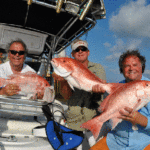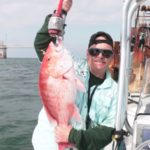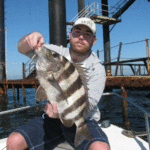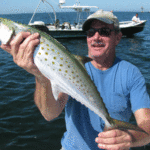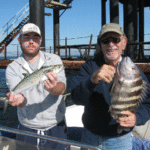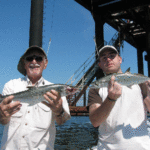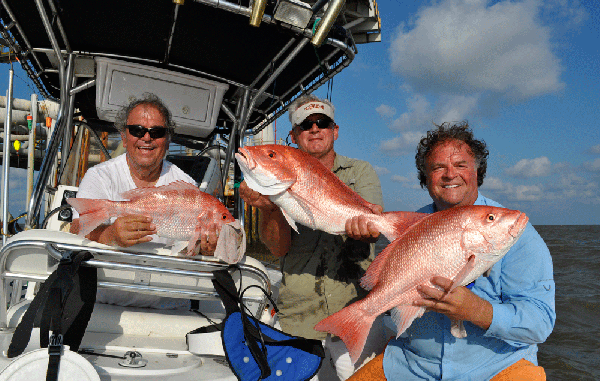
Red snapper aren’t the only fish swimming around structures just off the coast. Plenty of other fish are on the menu when you hit the shallow rigs.
“Ain’t no way!” Eddie snarled in response to Pelayo’s entreaty, which involved a “rig-fishing” trip.
Eddie, though only recently back from his northern exile after his second disbarment, was fully aware of the new and diminutive red snapper limits. He was also aware that bull croakers and white trout — for whatever reason — have long since vanished. And these two were always the mainstays that filled boxes during “rig-fishing” trips back when we were “Paaaw-tying Haaawty!” in Tigerland during the Disco era.
“With gas this high, and limits this low — ain’t no way!” Eddie snarled again while plopping down his drink, and spilling half on Doc’s patio table. “Heck, let’s fish the Causeway instead!”
Eddie had a point — if red snapper were to be our main quarry, that is. But that’s hardly what Pelayo had in mind. In fact, a feeding frenzy of mangroves, sheepshead, Spanish mackerel, pompano, triggerfish, spadefish, bluefish — all prized game and food-fish almost everywhere else on earth — can be easily provoked and exploited around our shallower “rigs” in early summer.
And, oh! Nowadays red snapper themselves inhabit these shallower rigs — in case you’re still interested after slugging it out with the above-mentioned bunch.
In other words, there’s no reason to bash you silly and bankrupt yourself on some 20-mile offshore haul.
So we hauled it to the (relatively close — eight miles) West Delta 31 block a week later.
First we went “downstairs” (as By Hek used to say) with the heavy Carolina rigs baited with whole pogies.
“He’s on!” Pelayo yelled with a heavy groan, as he started cranking — and cranking — and cranking. His rod was bent in a gorgeous arc, but it wasn’t moving.
“He’s on alright!” Eddie roared. “He’s on the rig, that is!”
Now Pelayo really groaned, as he put the rod down and reached for a glove to start pulling the line. Happens often. Big snapper (and grouper) really like to hug that structure, which means the rig’s beams out here. And it doesn’t take them long to wrap the line around them when hooked.
Some people have taken to backing up to the rig with motors rumbling, dropping down — then rumbling away from the rig at the first hint of a hook-up to avoid this very problem.
But we didn’t bother. We tied up with a rig hook, the old fashioned way. By the time Pelayo popped his line and re-rigged we had three red snapper on board.
Thirty minutes later we had our six, along with as bonus grouper. All had clobbered whole pogies in 50-foot depths.
“Ok, now what?” Pelayo asked — but rhetorically, because he knew perfectly well “what.”
In fact he was already reaching for his medium spinning rod, tipped with a leader and white beetle.
Spanish mackerel were the “what.” We love them, both as frenzied fighters and as delicacies. Heck, the 1921 edition of the Times-Picayune Creole Cookbook puts them up there next to pompano! And rightly so.
And hey, let that shrimp-tipped jig sink to mid-depths around the legs of these shallow-water rigs in early summer, and get set for Mr. Pompano himself (I can certainly live with that!) and triggerfish (if you ain’t eating them, you’re crazy) and mangrove and spadefish and catch-and-release reds.
Grouper numbers have also increased lately, and gag grouper are not necessarily a deep-water fish. Ask anyone who fishes the Florida Keys. We’re finding many in 40- to 50-foot depths.
It’s a fisherman’s buffet at our shallower rigs in early summer, my friends.
And for the life of us, we’ll never understand why people pass up these rigs (the 35- to 60-foot-deep ones from Ship Shoal, through Fourchon through the Grand Isle blocks to West Delta) on the way to the deeper ones in midsummer. The action’s here.
This action comes with medium-spinning tackle, short wire leaders and jigs. This ain’t rocket science.
Spanish mackerel hang at our shallower rigs all year long, but we always do best in midsummer. We always catch the biggest ones from June through August. They’re spawning this time of year. The big ones we catch (the 3- to 5-pounders) are all laden with eggs.
And you talk about a battle! You talk about a powerful missle of a fish! I’ll put a 2-pound Spanish against an 8-pound trout any day (not that I’ve ever caught the latter). Heck, I’d even put it up against a 5-pound red — for its ferocious runs especially. Nothing like it.
You hook up to these rigs in winter and spring, and drop down with shrimp-tipped jigs — you’ll have some dynamite fishing.
But the sheepshead typically won’t let the jig past them to the pompano, triggerfish and mangroves.
Cast away from the rig, and the Spanish are schooled out there alright — but in big, tight schools. These are smaller Spanish than in the summer.
Also, in winter/spring, you get your line snapped twice for every Spanish you boat. What happens is, while you’re fighting one, another in the school grabs the swivel on your leader that’s twirling around or just grabs the line out in front of it.
On the other hand, in the summer Spanish aren’t schooled up as tight. The individual fish are much bigger and more spaced out, not in tight schools. It’s the ideal time to battle them one on one.
“They’re here!” Eddie screeched slightly louder than the screeching of his reel’s drag.
“Here too!” howled Pelayo.
The fight was on. The battle had been joined. The Spanish feeding frenzy was starting.
Spanish love anything shiny or white. In a frenzy, sure, they’ll hit anything, but after years of targeting them, we’ve found that white beetles or shad rigs, Sidewinders, Mr. Champs (the old favorites) and the silvery-blue Rat-L-Traps take the cake.
Jerk them back on the retrieve violently. They usually smack it in between jerks. Short wire leaders and black swivels in front of these offerings will save you some bucks, too.
After a ferocious flurry of runs mixed with some surface thrashing, Eddie heaved his fish aboard. A beauty.
“Watch those teeth!” I howled, just as my rod was almost yanked from my grip by a savage hit.
I had cast behind the boat into the open water away from the rig. Spanish mackerel don’t hug the pilings like blues and hardtails. They’re more like kings: They like to circle the rig from the outside. In more than 30 years of diving these rigs, we’ve never seen more than a handful of Spanish actually swimming through the rig. They’re usually streaking about on the outside.
I stood on the bow with the pole over my head, just letting the sucker run, savoring every sizzling second.
“Run you maniac!” I screeched.
Ah, a beautiful Saturday morning on the Gulf with a gentle swell rocking the boat, good company on board, no black clouds on the horizon and a miniature rocket on the end of the line — nothing like it to let the imagination run free and crazy.
After about 40 yards of line had been stripped, I tightened the drag just as the spool started to appear through the few wraps of monofilament left.
I heard Eddie snap his bail, and then, “Whooo–oooh!” while watching his spool empty. “Powerful fish here!”
Complete bedlam took over our boat. In 10 minutes, we netted six Spanish.
Then came two pompano. They hit the little white jigs, too, but tipped with shrimp and close to the rig.
Then came a mangrove. It hit the same thing.
Then some triggerfish; they like small jigs and shrimp close to the pilings, too.
Sight-casting at a humongous sheepshead around a beam also paid off for Pelayo.
“Check it out!” Eddie whooped from the stern, as his pole bent and a bluefish went berserk on the surface. He’d tipped his jig with a little strip of hardtail, effective on both Spanish and blues.
Five strips of hardtail jack, and a half hour later we had boated six blues and five more Spanish.
An hour of non-stop, spool-sizzling action that no number of specks could ever hope to match.
Blues are what biologists call “pelagic” fish, which means they live in the “water column,” which means they don’t live or feed near the bottom.
Pelagics (mackerels, tunas, etc.) are constantly on the move. You won’t find them holed up in some crevice or curled up against some structure on the bottom.
They’re burning energy 24 hours a day, which means they require more fuel than bottom feeders. That fuel comes mainly from shredding and wolfing down other fish, and blues are almost constantly seeking them.
Ice down bluefish immediately, cut away the dark-red layer close to the skin after filleting, deep fry them in chunks until they just float (for maximum juiciness, don’t overcook them) and they’re great.
Leave the skin and scales on a bluefish fillet and grill it skin-side-down while basting it with lemon butter or barbecue sauce (like redfish), and you’re in for another surprise. Again, cook it for a shorter period than a red.
Cast around a rig in summer with a spoon or jig, and there’s really no telling what’ll grab it. And almost anything that does can strip your spool in seconds — and will prove delectable when freshly fried or grilled.
Scuba diving under the rigs has taught us that most of the fish around a platform tend to concentrate on the upcurrent side of the rig.
A study by the Coastal Fisheries Institute even confirmed our observations. CFI scientists dropped a contraption under rigs that takes sonar pictures of what’s down there, and monitored the pictures for 20 months. Yep, most of the blips where on the upcurrent side.
That’s why we like fishing the small well jackets that pepper the water between platforms in the shallow West Delta blocks. Here, the fish are more concentrated around the small area of structure, and although we are still downcurrent after we hook up to the structure, we can still cast our shrimp-tipped jigs in their vicinity, unlike around an acre-wide platform.
Not that it’s impossible, even at these.
Diving has also shown us that the direction of the current on the surface is sometimes the opposite of its direction 10 feet down, or 20 or 50. The water under our rigs is generally layered, with each layer going in an opposite direction from that on top.
So, often, you can hook up downcurrent of the fish but 20 feet down your bait is upcurrent of the structure — hence amidst the biggest concentrations of fish. You never really know from the surface.
We hooked up to one of these little well jackets, and not two minutes after dropping our shrimp-tipped jigs, three of us were fast onto fish, and fish that threatened to disable our medium spinning gear with their muscle.
Pelayo had a pompano, Eddie a spadefish and I was delighted to haul in a triggerfish.
I took him off and re-baited my small-hooked jig, but with cut hardtail this time, and hooked through the skin.
If trigs were around, I wanted plenty more. Triggerfish are nibblers more than strikers, notorious bait thieves.
“Check it out!” Eddie pointed as he looked up after putting his third spadefish (also notorious bait-stealers, also delectable) in our already bulging box.
Gulls were hovering over a frothing frenzy about 200 yards to starboard.
We headed over, killed the engine and drifted toward the melee. It was hard to tell what kind of fish they were, but it was a definite feeding frenzy.
Our four jigs landed in that churning, slashing cauldron of mangled shiners and blood-crazed predators almost at the same time.
Then all hell broke loose.
Three reels started singing, and four lunatics started whooping like crazed baboons — then two of the lines snapped.
Pelayo finally swung in a Spanish, and Eddie got spooled by a little tunny.
The next half hour was a frenzy of screaming spools, screaming people and furious re-rigging as lines snapped. It was the kind of action fishermen from other parts of the country (without rigs) only dream about, and local fishermen, for some insane reason, usually pass up — at least with these species of fish, all locally scorned.
Spanish, jack crevalle, blues, little tunny — everything was slashing at those shiners. Into that fracas we chunked beetles and shad rigs until our arms ached and muscles started cramping from the constant battle.
We skipped them across the surface with frantic retrieves, and the fish went nuts with blood lust.
The Spanish were grabbing our jigs. Then the blues started grabbing the Spanish on our jigs. Everything was in an utter frenzy of chasing, chomping and slashing. Our ice chest filled while our tackle box emptied.
Explaining why so many of us consistently overlook (if not actually scorn) this type of fishing, nearly always available a few scant miles off our coast, is a job for skilled psychiatrists.
I give up.
